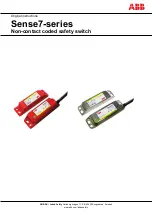
xStack DGS-3400 Series Layer 2 Gigabit Ethernet Managed Switch
36
looks long and cumbersome, there are some compression rules that will shorten the format of the IPv6 address to make it more
compatible to the user.
One such compression rule that is used is to remove leading zeros from any 16-bit hexadecimal value. This is only for zeros that
begin the value, not for zeros within the value or ones that are ending the value. Therefore, if we take the previous example IPv6
address and use the compression rules, our IPv6 address would look like this:
2D83:0C76:3140:
0000:0000:020C
:417A:3214
2D83:C76:3140:
0:0:20C
:417A:3214
The second compression method is to change a string of zero bits into two colons. At times, there may be strings of empty values
in the IPv6 address that are unused for this address, but they are necessary for the format of other IPv6 addresses with alternate
purposes. To compress these zero strings, the format “
::”
is used to represent multiple zero fields in the address. This double colon
can only be used once in the IPv6 address because when a computer finds a colon, it will expand this field with as many zeros as
is necessary to reach the 128-bit address size. If two strings of zeros are present, separated by another non-zero field, a zero must
be used to represent one of the two zero fields. So, if we reduce our example using this compression, it would look like this:
2D83:0C76:3140
:0000:0000:020C:
417A:3214
2D83:C76:3140
:0:0:20C:
417A:3214
2D83:C76:3140
::20C:
417A:3214
When IPv4 and IPv6 nodes are mixed in a network, the IPv6 notation overcomes the difficulty of using an IPv4 address by
converting it to the IPv6 format using zeros at the beginning of the IPv4 address. For example, an IP address of 192.168.1.1 is
represented in IPv6 format x:x:x:x:d.d.d.d where the x’s are a string of zeros and the d’s represent the normal IPv4 address. (ex.
0:0:0:0:192.168.1.1 or condensed ::192.168.1.1 or hex form ::C0A8:1:1).
Types
IPv6 addresses are classified into three main categories, unicast, multicast and anycast.
Unicast
– This address represents a single interface on an IPv6 node. Any packet with a unicast address as its destination address
will only be sent to that specific node. Two types of unicast addresses are mainly used for IPv6.
•
Link-Local
– Defined by the IPv6 address prefix FE80::/10, link-local addresses allow for communication to occur
between devices on a local link. These addresses are used in neighbor discovery and stateless autoconfiguration.
•
Global Aggregateable
- Defined using a global routing prefix in the range of 2000::/3 to E000::/3, global addresses are
aggregated using these routing prefixes to produce unique IPv6 addresses, which will limit global routing table entries.
The MAC address of the device is used to produce this address in this form:
Global Routing Site Level Aggr MAC address (first 3 bits) + FFFE + MAC Address (last 3 bits)
So if your MAC address looks like 00-0C-6E-6B-EB-0C, your IPv6 address may resemble
2000::C:6E:6B:FF:FE:EB:0C/64.
Multicast
– Like IPv4, multicast addresses are used to send packets to multiple destinations on a network. These interfaces must
be a part of the multicast group. IPv6 multicast prefixes begin with the prefix FF00::/8. FF represents the binary 1111 1111 which
identifies a multicast address. The first zero, which is a 4-bit integer, represents the lifetime of the packet. An entry of zero in this
field represents a permanent multicast address and an entry of one represents a temporary multicast address. The second zero,
which is also a 4-bit integer, defines the scope of the multicast address. This scope defines to what places the multicast address is
valid. For example, a value of 1 defines the node, 2 defines the link, 5 defines a site, 8 defines a organization and so on. Not all
integers are in use for the scope field. An example of this would be FF02 where the 2 represents a multicast packet going to all the
nodes on a local link.
Anycast
– The anycast address will send messages to the nearest node of a particular group. This address is assigned to multiple
interfaces in the group but only the node with the closest proximity will receive the message. These anycast addresses are
allocated from the unicast address space and therefore have no real defined prefix to distinguish it from other IPv6 addresses. The
main purpose of the anycast address is to identify a set of routers owned by an organization providing Internet service. It could
also be used to identify a set of routers connected to a particular subnet or permitting entrance to a specific routing domain.
Two other special types of addresses exist in IPv6. The
unspecified address
has a value of 0:0:0:0:0:0:0:0 which is comparable to
the 0.0.0.0 address in IPv4. This address is used to indicate the lack of a valid IP address on a node and may be used by a device
when booting and requesting address configuration notification. In its IPv6 condensed form, it appears as “
::
” and should not be
statically or dynamically assigned to an interface, nor should it be the destination address of an IPv6 packet, or located within the
routing header.
The second type of special address is the
loopback address
which is represented by 0:0:0:0:0:0:0:1, or ::1 in its compressed form.
It is akin to the 127.0.0.1 address in IPv4 and is used in troubleshooting and testing IP stacks. This address, like the unspecified
address, and should not be statically or dynamically assigned to an interface.
Содержание xStack DGS-3426
Страница 66: ...xStack DGS 3400 Series Layer 2 Gigabit Ethernet Managed Switch Figure 6 16 Cable Diagnostics window 52...
Страница 122: ...xStack DGS 3400 Series Layer 2 Gigabit Ethernet Managed Switch Figure 6 78 Port Speed Utilizing the Tool Tip 108...
Страница 146: ...xStack DGS 3400 Series Layer 2 Gigabit Ethernet Managed Switch Figure 7 18 Link Aggregation Settings Add 132...
Страница 202: ...xStack DGS 3400 Series Layer 2 Gigabit Ethernet Managed Switch Figure 9 17 Access Rule Display IPv6 188...
Страница 321: ...307 BSMI Warning MIC Warning CCC Warning A...
Страница 348: ...D Link D Link D Link D Link 495 744 00 99 http www dlink ru e mail support dlink ru...
Страница 354: ...International Offices...
Страница 356: ......
















































